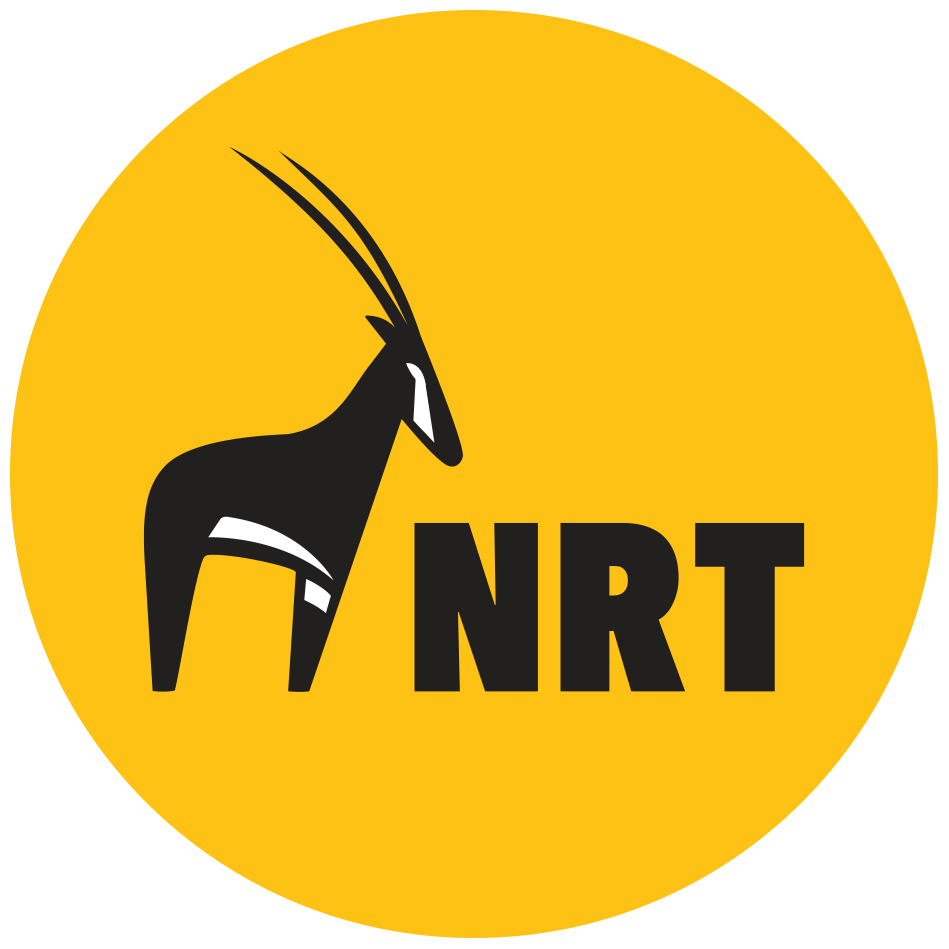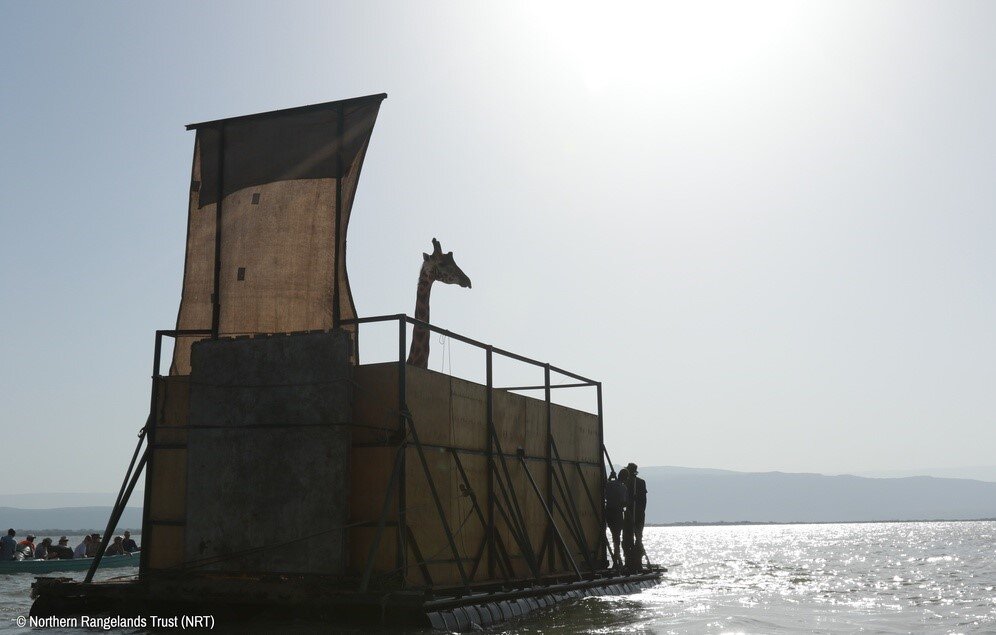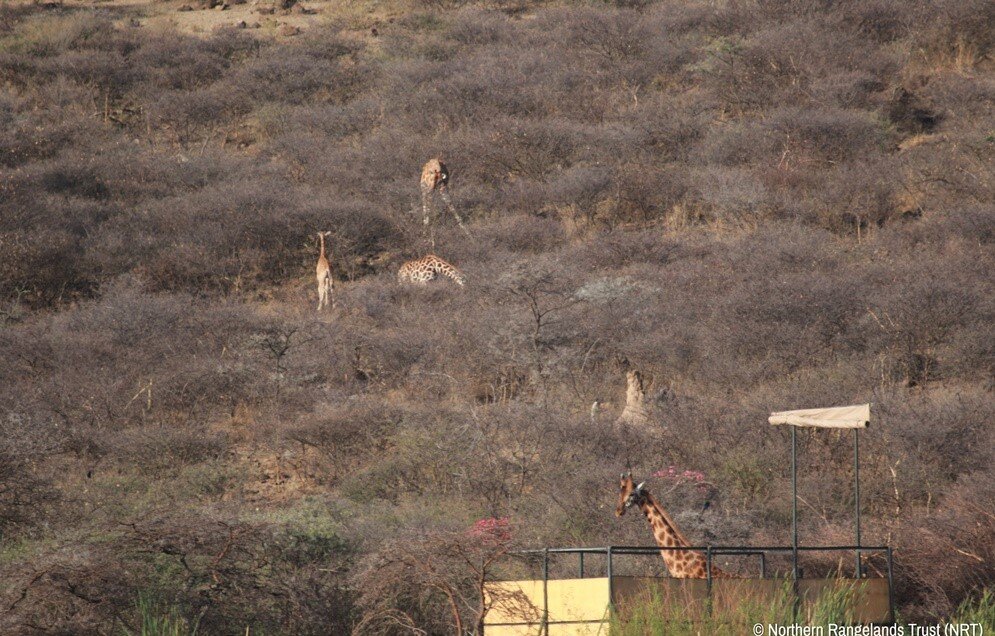One More Critically Endangered Rothschild Giraffe Moved to Safer Grounds from ‘disappearing’ Island
One more Rothschild’s giraffe has been rescued from Longicharo Island, on Lake Baringo, as rising water levels continue to shrink the size of the island and threaten the survival of the animals still trapped there. This follows the rescue of two giraffes in December 2020, and several other smaller wildlife species before that.
There are still six giraffes left on the island, all of whom will be moved over the coming months to a community-run giraffe sanctuary on the mainland of the Ruko Community Conservancy, thanks to a partnership with the Northern Rangelands Trust (NRT), the Kenya Wildlife Service and the US nonprofit Save Giraffes Now.
The most recent giraffe to be rescued – a male bull giraffe known as Lbarnnoti, voluntarily boarded a custom-made barge after becoming accustomed to it over the past few weeks. The barge was made by the Ruko community, out of steel and designed to float on top of a series of empty drums for buoyancy. It has tall reinforced sides to keep the giraffes from jumping out while being tugged by boats.
To ease the loading and translocation, Ruko Conservancy rangers have been supplementing the animal’s food while conducting routine health checks. They have been using mangoes, a favourite treat, to train them to board the barge, eliminating the need for sedation. Six giraffes remain on the island after a new female calf, named Noelle, was born on the 17th of December - a fortnight after two female giraffes Asiwa and Pasaka were moved to the mainland.
“It is a second success and we are happy that Lbarnoti becomes the third giraffe to be rescued, a true indicator of the dedication that the community has towards conservation of this rare, yet endangered species,” says Rebby Sebei, manager of Ruko Community Conservancy, “this will continue to be the bond that not only secures peace amongst our community but as well a gift to history and our grandchildren from community conservation,” she added.
The giraffe came to epitomise the transformational impact of nurturing peace through the community conservation model, as the previously conflicting Il Chamus and Pokot communities came together under one community conservancy – Ruko - to protect them. They were originally moved to Ruko in 2011, in a bid to reintroduce Rothschild’s giraffe, also known as the Baringo giraffe, back to their endemic range. Today, fewer than 3,000 Rothschild’s giraffe are left in Africa, with about 800 in Kenya. Approval to move the giraffes to a purpose-built sanctuary on the mainland was granted by the Kenya Wildlife Service (KWS) after lake levels started shrinking the island, with remaining food sources becoming scarce.
The Ruko giraffe also have faced challenges in breeding. Eight calves have been born, but just two have survived prior to the recent birth. The others are thought to have been lost to python predation, nutritional deficiencies and other natural causes – further necessitating the need for them to be moved. “This is a very noble exercise undertaken to help conserve and manage wildlife.
“It is a lifesaving activity that supports Kenya Wildlife Service’s mandate. We are always ready to complement all the efforts towards ensuring the endangered wildlife species are protected. We also hope to translocate the remaining animals though the help of the community and all other stakeholders involved in this exercise,” says the KWS Director General Brigadier (Rtd) John Waweru.
Lbarnnoti joins Asiwa and Pasaka in getting accustomed to their new location, food and landscape in a smaller section of the 17.7 square kilometre sanctuary, located within 44,000 hectares of Ruko Community Conservancy’s mainland. This will be the protocol for each giraffe moved. As they settle, the team from Ruko will then slowly release them into ever-larger areas of the sanctuary, where they’ll join other giraffe that will be re-introduced in future.
“It’s heartening to have three safely moved, but we won’t rest until the other six are safe at Ruko Conservancy, as well,” said David O’Connor, president of Save Giraffes Now.
“Giraffe are undergoing a silent extinction, and each one matters greatly to the survival of these animals.”
“The exercise was a success, and a tremendous achievement spear-headed by the community of Ruko hence fulfilling our key mission that of supporting a noble cause through the community conservation model, a game changer in conservation not only in Kenya but also in the south of Africa,” says Antony Wandera, NRT’s Senior Research and Monitoring Officer.
The giraffes are not only a symbol of unity but have also provided the Ruko communities with a valuable tourism opportunity. Prior to the COVID-19 pandemic, the conservancy welcomed about 500 guests yearly, approximately 200 of whom were school children coming from as far as Nairobi to see the giraffes. To increase tourism earnings, the conservancy has boat tours around the conservation area, raising awareness and opening the market for local entrepreneurs and youth groups around the island to sell beaded items and other wares.
Any tourism earnings received are split 60: 40 with 40% funding conservancy operations and the 60% split equally amongst the two communities in the region for healthcare and education. Since the conservancy’s inception over 300 bursaries have been provided to schoolchildren from both communities.
Ruko Community Conservancy is one of the 39-member community conservancies supported by the Northern Rangelands Trust and Baringo County Government, through generous partnership of United States Agency for International Development (USAID), The Nature Conservancy (TNC), the Embassy of Denmark in Kenya and Somalia through DANIDA, San Diego Zoo Global and Sidekick Foundation.
About Ruko Community Conservancy
Ruko Community Conservancy is a community-based organisation, created to support the management of community-owned land for the benefit of household livelihoods and for the conservation and protection of natural resources, particularly the Rothschild’s (Baringo) giraffe. It is home to the Il Chamus and Pokot communities, who work to build strong governance and peace structures, grow diversified local businesses linked to conservation, implement community-led development programmes and manage natural resources for people and wildlife alike. Ruko is one of 39 community conservancy members of the Northern Rangelands Trust.
About KWS
Kenya Wildlife Service (KWS) is a state corporation that was established by an Act of Parliament (Cap 376), now repealed by WCMA (2013), with the mandate to conserve and manage wildlife in Kenya, and to enforce related laws and regulations. KWS undertakes conservation and management of wildlife resources across all protected area systems, including community conservancies in collaboration with stakeholders.
About Save Giraffes Now
Save Giraffes Now is a registered 501(c)(3) non-profit committed to saving giraffe from extinction by supporting action-oriented projects with immediate impact. Headquartered in Dallas, Texas, with a base in Nanyuki, Kenya, Save Giraffes Now (SGN) creates awareness about the significantly declining giraffe populations in Africa and supports on-the-ground programs, such as de-snaring/anti-poaching efforts, rewilding, and community-led projects, to ensure a stable future for the iconic giraffe and the people who live alongside them. All donations to Save Giraffes Now go directly to projects in Africa. For more information, visit www.savegiraffesnow.org.
About NRT
The Northern Rangelands Trust is a community conservancy membership organization that works for 39 community conservancies across northern and coastal Kenya. With support from principal donors USAID, The Nature Conservancy, DANIDA, and the European Union - NRT and the community conservancies are transforming lives, building peace and conserving natural resources. This indigenous movement is empowering communities to develop locally-led governance structures, implement rangelands management and wildlife conservation programmes, identify and lead development projects, and manage sustainable businesses linked to conservation. Their success has helped shape new government regulations on establishing, registering and managing community conservancies in Kenya.






